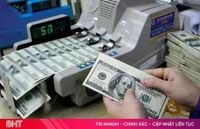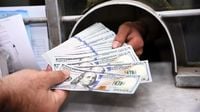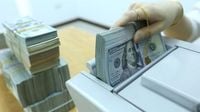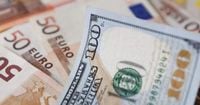The USD Exchange Rate Today April 12 2025: As of 4 AM on April 12, the central exchange rate at the State Bank is 24,923 VND/USD, down 41 VND from the previous trading day. Specifically, at Vietcombank, the USD exchange rate is 25,530 - 25,920 VND/USD, a decrease of 50 VND in both buying and selling directions compared to the previous trading day.
The VIB bank is buying cash USD at the lowest price of 1 USD = 25,340 VND, while they are buying USD via transfer at the lowest price of 1 USD = 25,400 VND. On the other hand, the OCB bank is buying cash USD at the highest price of 1 USD = 25,860 VND. VietinBank is buying USD via transfer at the highest price of 1 USD = 25,990 VND.
For selling rates, VIB is selling cash USD at the lowest price of 1 USD = 25,760 VND, and also selling USD via transfer at the same lowest price of 1 USD = 25,760 VND. In contrast, OCB is selling cash USD at the highest price of 1 USD = 26,182 VND and also selling USD via transfer at the same highest price of 1 USD = 26,182 VND.
On the black market, as of 4 AM on April 12, 2025, the USD exchange rate has decreased by 60 VND in both buying and selling directions compared to the previous trading day, trading around 25,994 - 26,094 VND/USD.
Global Market Overview: On April 12, 2025, the Dollar Index (DXY), which measures the USD against six major currencies (EUR, JPY, GBP, CAD, SEK, CHF), stood at 99.99, down 1.04 points compared to April 11, 2025.
U.S. Treasury Secretary Scott Bessent stated on Wednesday that the plan for most U.S. trading partners is to ease tariffs once countries sit down at the negotiating table. However, President Trump pointed out that the chaos in the market since he announced tariffs on April 2 has been taken into account in his considerations.
The DXY has dropped by 1.2%, temporarily falling below 100 for the first time since July 2023. "I am extremely concerned about the lack of confidence among investors in the U.S. right now," said Naka Matsuzawa, a strategist at Nomura. "This is a vote of no confidence not only from the stock market but also from Treasury bond market participants against the Trump administration and its policies."
Safe-haven assets have seen notable movements, with the USD dropping to 0.81150 Swiss francs in early European trading, marking the lowest level since January 2015, extending a nearly 4% decline from Thursday. The Swiss National Bank (SNB) has stated they have no comments on the franc's appreciation. "The SNB is in a difficult position. They may want to intervene more, but it's currently challenging. I don't see them doing this on a large scale," said Michael Pfister, a currency analyst at Commerzbank. He added that the franc's appreciation would concern the SNB due to its deflationary impact.
The USD also fell by 1.4% against the Japanese yen to 142.37 yen, with the last trade down 1.2%. Vis Nayar, an investment director at Eastspring Investments in Singapore, noted that the U.S. administration's tariff policies show less concern about a strong USD. "On the other hand, risk aversion still tends to favor the USD, but we have seen over the past week that the USD will decline. U.S. exceptionalism? I think that has now been challenged," he remarked.
The Euro has increased by 1.14% to 1.136025 USD, previously rising by 2.5% to its highest level in three years. It also rose by 0.5% against the British pound, indicating its superiority. The British pound gained 1% against the USD, standing at 1.30930 USD.
European Central Bank President Christine Lagarde stated on Friday that the central bank is ready to deploy its tools to maintain financial stability and has a solid history of building tools as needed to address chaos.
Meanwhile, the Chinese yuan has sharply fallen against the euro, with the euro reaching an 11-year high against the yuan in the offshore market. This week, the yuan fell to a record low against the USD, both onshore and offshore, although it has since recovered somewhat. The USD last traded down 0.2% against the offshore yuan, at 7.2965.
Market analysts are closely observing these fluctuations, as they indicate a broader trend of investor sentiment shifting away from the USD amid rising trade tensions and economic uncertainty. The recent increase in tariffs by China on U.S. imports, from 84% to 125%, has further exacerbated concerns about the stability of the USD.
As the market reacts to these changes, many are questioning the long-term implications for the USD and whether it can maintain its status as the world's primary reserve currency. The ongoing economic dynamics suggest that the USD's reign may be challenged as global investors seek alternatives amid rising fears of recession.
In summary, the USD continues to face significant headwinds as it depreciates against major currencies, driven by a combination of trade tensions, changing investor sentiment, and economic uncertainties. The coming weeks will be critical in determining whether this trend will continue or if the USD can regain its footing in the global market.







